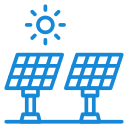Solar Plant
- Home
- Solar Plant
Type Of Services
- Bio Gas
- Demineralization Plant
- Commercial RO Plant
- Industrial RO Plant
- RO Desalination Solutions
- Effluent Treatment Plant (ETP)
- Membrane Bio Reactor (MBR)
- Membrane Aerated Biofilm Reactor (MABR)
- Moving Bed Bio Reactor (MBBR)
- Organic waste composter (OWC)
- Commercial RO Plant
- Sequence Batch Reactor (SBR)
- Sewage Treatment Plant (STP)
- Softener Plant
- Ultra Filtration
- Zero Liquid Discharge Treatment (ZLD)
- Solar Plant
Solar Plant
A Solar Plant is a power generation system that converts sunlight into electricity using photovoltaic (PV) panels or solar thermal technology. It provides a renewable, eco-friendly, and cost-effective energy solution, reducing dependency on fossil fuels.

How Does a Solar Plant Work?
- Solar Panel Absorption – Photovoltaic (PV) cells capture sunlight and convert it into direct current (DC) electricity.
- Conversion to AC Power – An inverter converts DC electricity into alternating current (AC) for use in homes, industries, and businesses.
- Energy Distribution – The generated electricity is supplied to the grid or directly used for self-consumption.
- Battery Storage (Optional) – Excess energy can be stored in batteries for use during nighttime or low sunlight conditions.
For solar thermal plants, mirrors concentrate sunlight to heat water, creating steam that powers a turbine to generate electricity.
Advantages:
- Renewable and sustainable energy source.
- Reduces electricity bills and long-term energy costs.
- Low maintenance and long operational lifespan.
- Eco-friendly with zero carbon emissions.
- Scalable solution for residential, commercial, and industrial use.
- Energy independence, reducing reliance on fossil fuels.
- Government incentives and subsidies available in many countries.
Applications:

Residential Rooftop Systems

Commercial & Industrial Use

Agriculture & Farming

Hospitals & Educational Institutions

Remote & Off-Grid Areas


